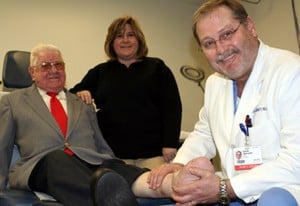Keith Bennett, M.D., Calls on Unique Skills to Heal Foot Wound
| Jan. 7, 2010 | Eighty-six-year-old Robert E. Foust didn’t think much about it when he stepped on the angular blue rock near his home in Pine Bluff; he tossed it to the side of the street and returned from his walk. But a few days later his wife noticed a significant bruise on that foot, and things got worse from there. Over the course of a few weeks the wound became infected and burst open near where Foust, a diabetic, had a recent amputation of his big toe. The infection began to invade bones, which prompted the amputation of the remaining four toes. Treatment for the wound was standard saline wet-to-dry dressing changes, but there was no improvement in the intensely painful wound for more than a year. A vascular surgeon determined that Foust, who has severe peripheral vascular disease, was not a good candidate for surgery and doubted that an effective treatment option was available. As a last resort he referred him to UAMS’ Keith G. Bennett, M.D., director of the UAMS Wound Center. “It was one of the worst-looking wounds I’ve ever seen and one of the more challenging cases I’ve encountered,” Bennett said. “Without some immediate improvement, Mr. Foust was facing a below-the-knee amputation.” Bennett’s first steps included making sure Foust’s blood sugars were normalized, that he maintained a normal blood pressure and was not anemic. He removed infected bone and tissue at the base of the wound. He then measured the blood/oxygen levels in the foot, which revealed that the oxygen level was so low it was doubtful the wound would ever heal. Bennett put Foust on oxygen and the oxygen level in the wound area increased significantly. But the lack of blood flow inhibited healing. To promote better flow, Bennett tried a unique application of Clonidine TTS patches, used primarily to treat high blood pressure. Placed near the wound site, the patch increased the blood supply by relaxing the vessels’ muscular walls. In addition, Bennett treated Foust intermittently with human growth factors and, an antimicrobial dressing. The combination of treatments led to dramatic improvements over just a few months’ time; the wound closed, scabbed over and was completely healed within seven months of Bennett’s initial treatment. The patient was then weaned off the oxygen and Clonidine patches one month at a time. “Dr. Bennett was the difference,” said a grateful Foust during a follow-up visit. “He saved my foot when nobody else could.” By salvaging Foust’s foot, Bennett also likely extended Foust’s life expectancy. Mortality after a below-the-knee amputation in diabetic patients is about 50 percent after five years. In addition, coping with a prosthesis requires 30-50 percent more energy, which makes it extremely difficult, if not impossible, for some elderly patients because their energy reserves are significantly below that of a younger patient, Bennett said. Bennett, who is board certified in surgery, plastic surgery and family medicine, said finding the right combination of treatments to heal Foust’s wound is a result of his training and experience. “Wound care is like anything else; over time, you learn different tricks and caveats that will help you help the patient,” Bennett said. “But this case, in particular, required me to think outside the box a little bit.” Bennett said that all wounds are different and tend to have their own “personality.” Treatments of difficult wounds have to be individualized in the majority of cases. “This case is an example of just that, individualizing the treatment for Mr. Foust,” he said. “The result – success!”
|
